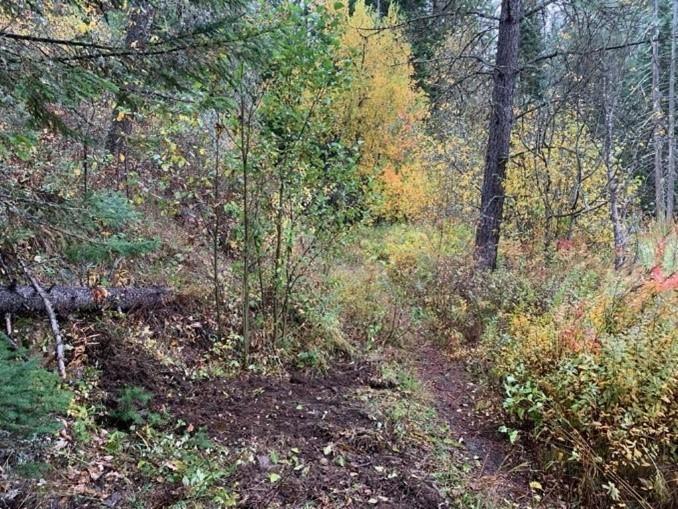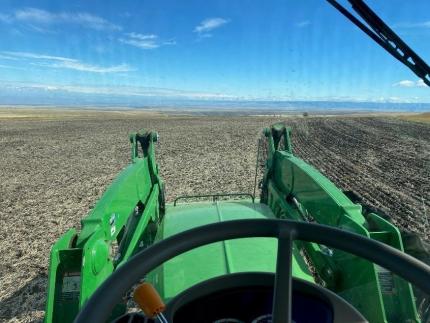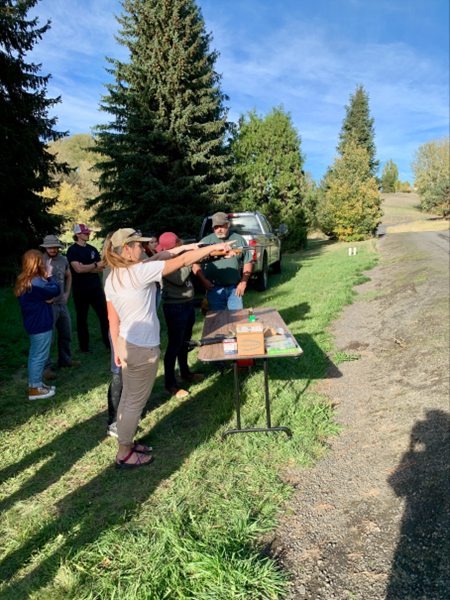Managing Wildlife Populations
Grouse Collection Barrels: Biologist Brinkman checked forest grouse wing/tail barrels. A total of three samples were collected this week.
Hunters place harvested wing and tails into one of the provided paper bags and drop it into a collection barrel. The samples are collected and stored in the freezer until grouse season ends. After the hunting season, usually in February or March, biologists from across the state have a “Wing Bee” to examine samples and collect data to help inform statewide harvest metrics.

Chronic Wasting Disease (CWD): Private Lands Biologist Nizer collected a CWD sample from a successful muzzleloader hunter harvest. The sample was given to Ungulate Research Scientists Devivo.
Nizer and Natural Resource Technician Rumiser posted CWD brochures at Washington Department vendors in Whitman and Lincoln counties.
Natural Resource Technician Heitstuman checked local pits for CWD samples and collected a sample from a cow elk in the Cloverland area. Four calls from the Washington State Department of Transportation were relayed to closer employees and samples were collected for CWD testing. Heitstuman met with the Clarkston area supervisor for the Washington Department of Transportation and was informed of a possible new pit collection site.
Lake Rehab Assistance: Sherman Creek Wildlife Area Assistant Manager Palmer, Water Access Area Manager Dziekan, and Natural Resource Technician Brant assisted Fish Program staff at Williams Lake in Stevens County. Dziekan worked with the shore crew, and helped Palmer load a dump trailer with empty, washed rotenone barrels. Palmer used his mini excavator to crush the barrels, enabling them to fit the barrels in one trailer and take them to the dump.
Brant spent the day on the boat with Fish Biologist Osborne. Brant ensured the powdered piscicide was mixed with water and spread onto the lake while Osborne piloted the boat. The distribution of this rotenone was completed by noon, after which only Fish Program staff members applied liquid rotenone to the shallows.



Chronic Wasting Disease (CWD) Sampling: Wildlife Conflict Specialist Samsill collected two CWD samples and submitted them for testing. Both samples came from mature does harvested with Damage Prevention Permits.
Acting Private Lands Biologist Nizer worked at a chronic wasting disease check station in Washtucna. Nizer taught four Washinton State University wildlife major students how to sample for CWD and how to educate the public. Deer were sampled at the station from Oct. 14 through Oct. 15.
Sharp-tail Grouse: Wildlife Area Assistant Manager Rimmelspacher and Wildlife Area Manager Finch did a sharp-tail grouse fall lek survey this morning to see if any resident sharp-tailed grouse males are attending the leks. If there are several birds attending the leks in the fall, trapping maybe warranted to collar a bird and use the telemetry information for winter movements.
Chronic Wasting Disease (CWD): Natural Resource Technician Tritt and Scientific Technician Moberg placed a reminder sign at the Delaney Department of Transportation pit asking staff members to let Washington State Department of Fish and Wildlife know when they drop a deer carcass off at the pit.
Wildlife Area Manager Dingman and Tritt organized sampling kits for chronic wasting disease (CWD) check stations. Dingman worked opening weekend of general deer season at the Last Resort Campground on the Tucannon and collected 37 CWD samples from hunter harvested deer. Tritt worked opening weekend of general deer season at the Asotin check station and collected 14 CWD samples from hunter harvested deer.

Providing Recreation Opportunities
Once in a Lifetime Opportunity: Wildlife Conflict Specialist Kolb assisted an out-of-state hunter with a special elk permit for game management unit (GMU) 149. Kolb spoke with a landowner who does not normally allow hunting who agreed to let the hunter onto their property. The hunter was successful and harvested a large mature bull. The hunter asked if I would pass along the following message to Washington Department of Fish and Wildlife staff members, “Please extend my sincere appreciation for this amazing opportunity that you all provided. It will be an epic memory that I’ll have for the rest of my life. Thank you!”

West Medical Lake Access Site, Grey Fire: Access Manager Dziekan talked with Greg Hayford from Washington State Department of Social and Health Services (DSHS) Medical Lake Facility. They are currently working with cleanup crews and forestry personnel falling burned trees and shrubs.
Washington State Department of Fish and Wildlife properties and facilities on West Medical Lake and Silver Lake have been affected by the fires and Hayford would like to take down some of the damaged trees. Dziekan wanted to identify the damaged trees that need to be removed and mark them with paint before approval. Dziekan identified 18 dead Ponderosa trees that need to be removed for public safety.
The DSHS Medical Lake Facility will be taking down the damaged trees at no cost to Washington State Department of Fish and Wildlife. They will have a crew fall the trees and Avista Corp will be chipping the wood and hauling it to one of their facilities in Kettle Falls.
Recreation Access Maintenance: Access staff members cleaned access sites across the district. They also hung new signage at Coues Creek and put together new ADA signage.

Hunter Check Stations: Biologists Lowe and Brinkman ran a hunter check station along Highway 395, north of Deer Park, to talk to hunters participating in the opening weekend of the modern firearm deer season. Biologists collected samples from hunter-harvested deer as part of a chronic wasting disease (CWD) surveillance effort in Region 1. Student volunteers from Washington State University assisted with the sampling effort both days the check station was open.

Hunter Harvest Inspection: Biologists Lowe and Brinkman checked in a mountain goat harvested from Goat Rocks West hunt area, and pinned a juvenile bighorn sheep ram that was harvested by a hunter in the Chelan Butte hunt area.
Biologists obtain measurements and take nasal swabs to test for M. Ovi (short for Mycoplasma ovipneumoniae) which is a bacterium that can be devastating to bighorn sheep populations as it can persist in healthy adults, but infection can be fatal to lambs. Additionally, they insert a pin into the horn to uniquely identify the animal and make it legal for the hunter to possess the skull.
Additionally, a bobcat was brought to the Deer Park check station and was pelt-sealed by Biologist Lowe.
Brush Clearing on Trails: Sherman Creek Wildlife Area Assistant Manager Palmer spent Tuesday through Thursday using his mini excavator to clear brush from several lengths of non-motorized trail at Rustlers Gulch Wildlife Area.


Reardan Audubon Wildlife Area: Access Manager Dziekan went to the Reardan site to work and noticed some tagging inside the restrooms on the south parcel. Dziekan walked around the restrooms and found graphic tagging on the entire backside of the restroom. Dziekan did the very best to clean up the tagging using up the last of the graffiti remover that was on the truck. Dziekan had a difficult time getting it off but between extra elbow grease and the chemical it became illegible when standing behind the restroom trying to read it.

Providing Conflict Prevention and Education
Cloverland Elk Stuck in Cattle Guard: Wildlife Conflict Specialist Wade received a call regarding a cow elk that had fallen through a cattle guard in a producer’s driveway. Wade, Private Lands Supervisor Earl, and Natural Resource Technician Heitstuman traveled to the area to evaluate the elk’s injuries and determine a plan of action to get it out of the cattle guard. After evaluation, it was determined that the best course of action was to chemically immobilize the elk and lift it out. Wade contacted District Biologist Wik who traveled to the area to immobilize the elk. Despite the best efforts of the team the elk died three days later. Wade and Natural Resource Technician Heitstuman with the assistance of the producer collected the carcass for CWD sample collection and disposal at the Asotin County Landfill.

Portable Electric Fence: Wildlife Biologist Prince and Private Lands Conflict Technician Barron assisted with the installation of a portable electric fence around sheep and goats in the general area where a grizzly bear was recently photographed on a trail camera. No conflict was reported; this was a proactive measure.
Beaver Relocation: Wildlife Conflict Specialist Kolb continues to work with a permitted beaver relocator and other department staff members to determine the feasibility of relocating a conflict beaver within the Walla Walla River watershed.
Conserving Natural Landscapes
Weed Control: Natural Resource Technician Meisner worked on fall weed control. He sprayed rush skeleton weed that has gotten out of control in a remote area. The skeleton weed was most likely brought in by trespassing cattle. Lack of personnel has greatly hindered the treatment efforts.
Food Plots: Biologist Woodall spent most of a week seeding annual food plots on Smoothing Iron Ridge. It is three to four weeks behind when this task is normally complete due to personnel shortages. He will continue and hopes to finish quickly.


Wooten Floodplain Management Plan: Wildlife Area Manager Dingman and Natural Resource Technician Tritt completed the Year 5 monitoring of the Rainbow Lake wetland that was created during the Rainbow Lake reconfiguration project. The Year 5 monitoring report was completed and sent to the Corps.


Providing Education and Outreach
Washington State University Labs: Private Lands Biologist Nizer, Ungulate Research Scientist Devivo, and Natural Resource Technician Heitstuman helped with a darting lab at Washington State University. Nizer helped train students on how to properly and safely use a dart gun on a standing deer decoy at about 35 yards.

The wildlife conflict supervisor taught a wildlife trapping lab for the 29th year at Washington State University (WSU). Private Lands Biologists Earl and Nizer and Natural Resource Technician Rumiser assisted with the lab. They set up a rocket net, discussed species it can be used on, and set it off. Then they demonstrated the net gun and what it can be used for. McCanna covered the Washington Department of Fish and Wildlife’s mission, future job opportunities, wildlife professions in general, and answered all kinds of great questions. The lab was split into two days with 52 students in total.
Third Annual Chris Christensen Memorial Youth Deer Camp: Wildlife Conflict Specialist Samsill instructed and mentored seven first time deer hunters at a youth deer camp in Kettle Falls.